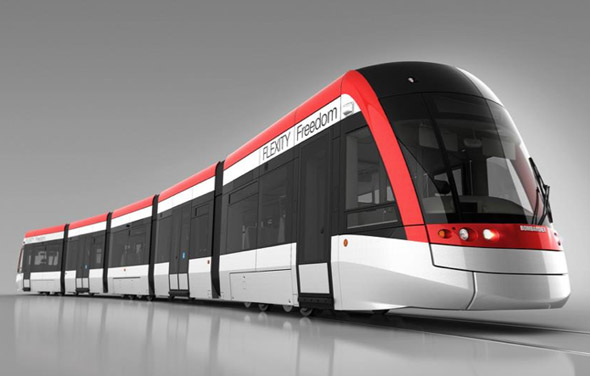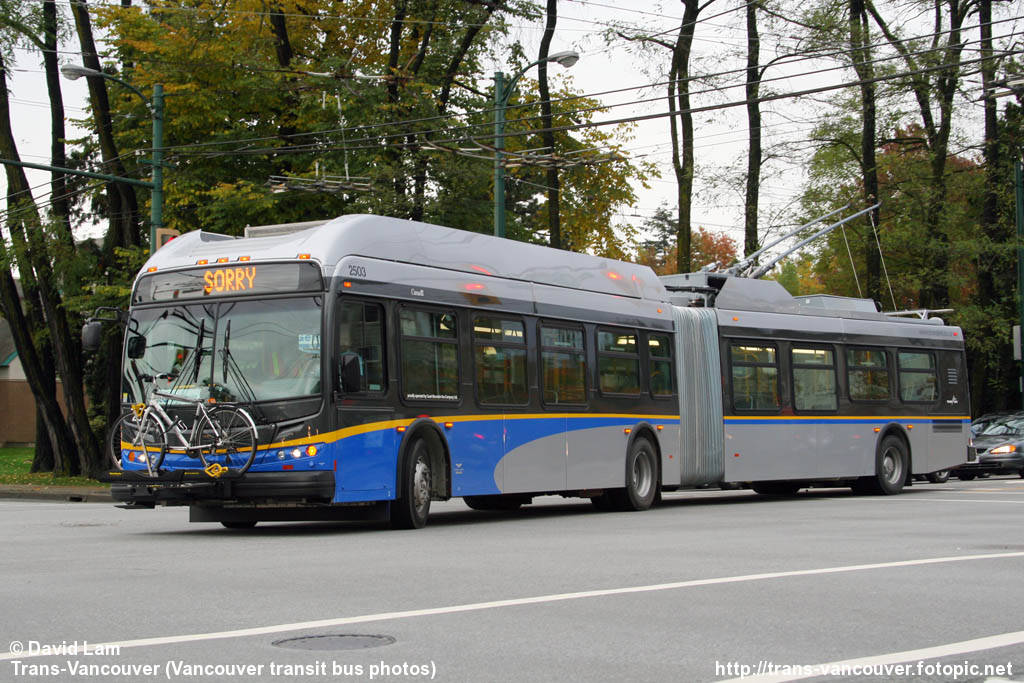
AvBrand Exploring Technology
An argument for Electric Trolley Buses in Toronto
12:42 PM, June 23rd, 2014
I was recently given a flyer by a friend, published by Toronto's transit company, the TTC. The flyer advertised the arrival of our new streetcar fleet, being delivered between late 2014 and 2018, purchased to replace our aging fleet of existing streetcars that have been in service since the late 70's.
The new streetcars are made by Bombardier and are called "Flexity". They are made up of five pieces, separated by 4 articulating sections. With the floor only 12 inches off the ground, they should be easier to ride for people with mobility issues. An extendable ramp helps wheelchairs, scooters, and carriages on board.

The TTC has ordered 204 of these streetcars, at a cost of $1.2-billion, or about $5.8-million each. The streetcar is 98 feet long, seats 70, and can carry an additional 181 standing passengers, for a total estimated capacity of 251 people. They are powered by a pantograph system that draws electricity from overhead wires, and have a maximum speed of 70 km/h. They are expected to last 30 years.
Sounds great, right? Except, anyone who has used the streetcars in Toronto has probably noticed that the system isn't ideal. Streetcars share the road with cars, trucks, and bicyclists on most routes, and require traffic to come to a stop to take on or disgorge passengers. At other times, they are at the mercy of the traffic in front of them. During rush hour, streetcars can average less than 5 km/h.
Streetcars are also unable to navigate around obstacles in the road, such as broken-down cars, delivery vehicles parked too far into the track, left-turning vehicles, other streetcars, and more. Since they ride on a track, the only directions they may turn is where the track exists and where the mechanical switch is functional. This track network is another problem: It must be constantly repaired and maintained, at great cost. Usually, a main thoroughfare must be closed for months as the tracks are completely replaced, one rail at a time, and this work lasts only 10-20 years. St. Clair Avenue was recently upgraded to have a streetcar right-of-way, at a cost of $106-million.
Beyond the cost of the new streetcars themselves, the required infrastructure to support them is also expensive. The TTC is spending $700-million on building a new carhouse, upgrading platforms, installing curb cuts, and more. This brings the total price tag for these new streetcars to $1.9-billion.
But is there a better way?
There is. A transit vehicle exists that has a lower cost-per-passenger, much lower infrastructure costs, and at the same time, solves many of the other issues that plague streetcars. That vehicle is the electric trolley bus.
Once upon a time, Toronto had a small fleet of electric trolley buses, and a few lines on which they ran. The last of these was shut down in 1992, apparently to avoid the cost of maintenance that the electric lines required, and due to the promised efficiency of natural gas buses. Those buses have turned out to be not as promised, and the TTC has all but abandoned the natural gas-powered bus.

Pictured is the Flyer E60LFR, found in Vancouver
Electric trolley buses have been in use for many years in Vancouver, with great success. They have the energy efficiency and cleanliness of electric streetcars, but without many of the restrictions. They are able to navigate into and out of bus bays, as well as traverse both lanes of traffic, so passengers do not need to cross live lanes. They are just as friendly to people with mobility issues, featuring low-floor boarding and extendable ramps. The capacity is not as high as our new streetcars, but is still respectable: 47 seated, 73 standing, for a total of 120 passengers.
The big savings come in the form of cost. In Vancouver, a recent extension of a trolley-bus line of 3.1km cost a mere $1.5-million, or about $483,000 per kilometre. The above-road electric lines also require far less maintenance than in-ground tracks, as they are not subject to tires, road salt, plowing, and other maintenance. The single biggest line-item on savings is the cost of each vehicle, hovering just around $700,000, or over 8 times cheaper than the Bombardier FLEXITY. The cost per passenger (that is, the cost of the vehicle divided by capacity) is just $5,800, compared with $23,400 on the streetcar. And that's not even taking into account that giant streetcar $700m infrastructure price tag.
These buses are cheaper than streetcars, quieter than streetcars, can go where streetcars can't go, and don't require an expensive and limiting track network. It seems like a no-brainer to me: Toronto needs electric trolley buses!
Do I expect to see electric trolley buses on Toronto's streets anytime soon? No. It's very unlikely that Toronto will move away from her beloved streetcars, despite the many problems they inherently possess. But I'd like to at least imagine a future where traffic doesn't have to move at the speed of these giant behemoths as they lumber noisily along the street.
The new streetcars are made by Bombardier and are called "Flexity". They are made up of five pieces, separated by 4 articulating sections. With the floor only 12 inches off the ground, they should be easier to ride for people with mobility issues. An extendable ramp helps wheelchairs, scooters, and carriages on board.

The TTC has ordered 204 of these streetcars, at a cost of $1.2-billion, or about $5.8-million each. The streetcar is 98 feet long, seats 70, and can carry an additional 181 standing passengers, for a total estimated capacity of 251 people. They are powered by a pantograph system that draws electricity from overhead wires, and have a maximum speed of 70 km/h. They are expected to last 30 years.
Sounds great, right? Except, anyone who has used the streetcars in Toronto has probably noticed that the system isn't ideal. Streetcars share the road with cars, trucks, and bicyclists on most routes, and require traffic to come to a stop to take on or disgorge passengers. At other times, they are at the mercy of the traffic in front of them. During rush hour, streetcars can average less than 5 km/h.
Streetcars are also unable to navigate around obstacles in the road, such as broken-down cars, delivery vehicles parked too far into the track, left-turning vehicles, other streetcars, and more. Since they ride on a track, the only directions they may turn is where the track exists and where the mechanical switch is functional. This track network is another problem: It must be constantly repaired and maintained, at great cost. Usually, a main thoroughfare must be closed for months as the tracks are completely replaced, one rail at a time, and this work lasts only 10-20 years. St. Clair Avenue was recently upgraded to have a streetcar right-of-way, at a cost of $106-million.
Beyond the cost of the new streetcars themselves, the required infrastructure to support them is also expensive. The TTC is spending $700-million on building a new carhouse, upgrading platforms, installing curb cuts, and more. This brings the total price tag for these new streetcars to $1.9-billion.
But is there a better way?
There is. A transit vehicle exists that has a lower cost-per-passenger, much lower infrastructure costs, and at the same time, solves many of the other issues that plague streetcars. That vehicle is the electric trolley bus.
Once upon a time, Toronto had a small fleet of electric trolley buses, and a few lines on which they ran. The last of these was shut down in 1992, apparently to avoid the cost of maintenance that the electric lines required, and due to the promised efficiency of natural gas buses. Those buses have turned out to be not as promised, and the TTC has all but abandoned the natural gas-powered bus.

Pictured is the Flyer E60LFR, found in Vancouver
Electric trolley buses have been in use for many years in Vancouver, with great success. They have the energy efficiency and cleanliness of electric streetcars, but without many of the restrictions. They are able to navigate into and out of bus bays, as well as traverse both lanes of traffic, so passengers do not need to cross live lanes. They are just as friendly to people with mobility issues, featuring low-floor boarding and extendable ramps. The capacity is not as high as our new streetcars, but is still respectable: 47 seated, 73 standing, for a total of 120 passengers.
The big savings come in the form of cost. In Vancouver, a recent extension of a trolley-bus line of 3.1km cost a mere $1.5-million, or about $483,000 per kilometre. The above-road electric lines also require far less maintenance than in-ground tracks, as they are not subject to tires, road salt, plowing, and other maintenance. The single biggest line-item on savings is the cost of each vehicle, hovering just around $700,000, or over 8 times cheaper than the Bombardier FLEXITY. The cost per passenger (that is, the cost of the vehicle divided by capacity) is just $5,800, compared with $23,400 on the streetcar. And that's not even taking into account that giant streetcar $700m infrastructure price tag.
These buses are cheaper than streetcars, quieter than streetcars, can go where streetcars can't go, and don't require an expensive and limiting track network. It seems like a no-brainer to me: Toronto needs electric trolley buses!
Do I expect to see electric trolley buses on Toronto's streets anytime soon? No. It's very unlikely that Toronto will move away from her beloved streetcars, despite the many problems they inherently possess. But I'd like to at least imagine a future where traffic doesn't have to move at the speed of these giant behemoths as they lumber noisily along the street.